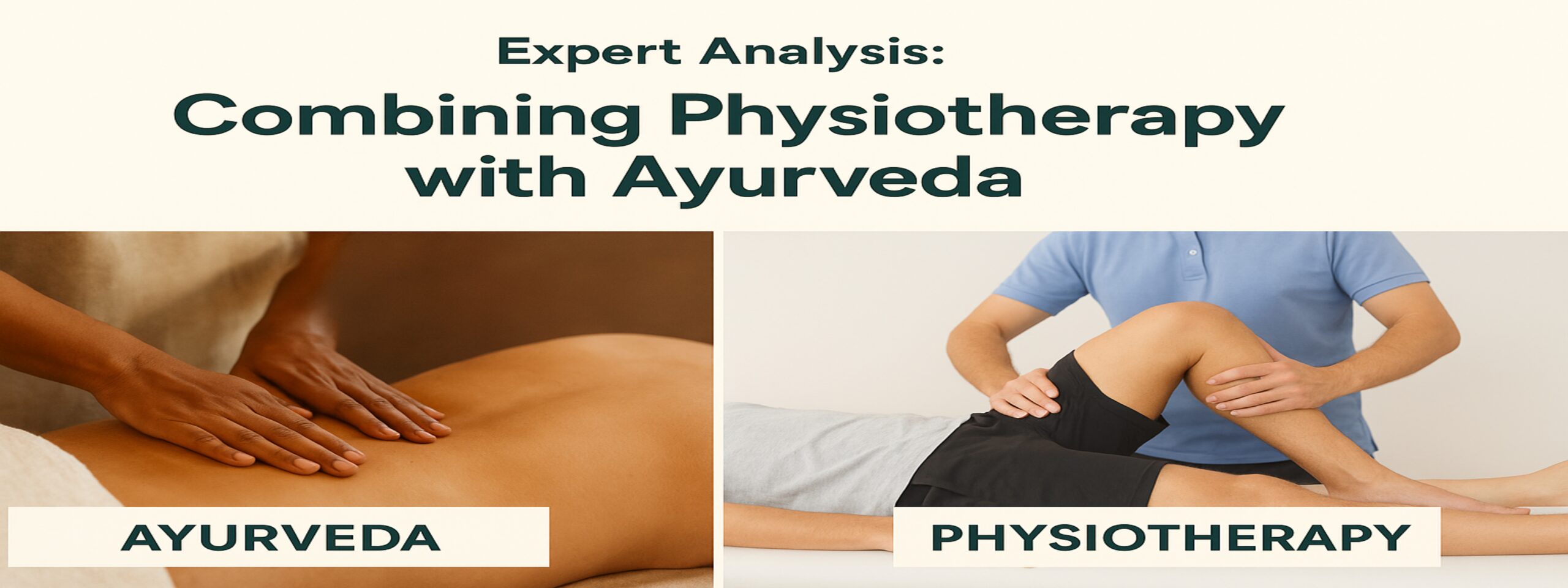Introduction: Merging Two Healing Sciences for Complete Recovery
Modern physiotherapy and ancient Ayurveda may seem worlds apart — one based on biomechanics, the other on natural balance. Yet, when combined, they create a powerful approach to healing pain, restoring movement, and improving quality of life.
This synergy — known as physiotherapy–Ayurveda integration — is gaining global attention. Experts suggest that combining the precision of physical therapy with the holistic depth of Ayurveda results in faster recovery, reduced inflammation, and sustainable wellness.
This expert analysis explores how the two systems complement each other, backed by both traditional wisdom and modern clinical understanding.
Understanding the Foundations of Integration
Before exploring the combined approach, let’s look at the principles behind each science:
- Physiotherapy focuses on restoring function, movement, and strength through targeted exercises, manual therapy, and rehabilitation.
- Ayurveda, on the other hand, emphasizes balance — addressing the root cause of physical discomfort by correcting dosha imbalances (Vata, Pitta, Kapha), detoxifying the body, and nurturing tissues (dhatus).
When integrated, Ayurveda supports internal healing, while physiotherapy rebuilds external function — together offering complete recovery rather than temporary relief.
🧠 Expert Insight: “Ayurveda restores the terrain; physiotherapy retrains the body to move within it.”
Key Benefits of Physiotherapy–Ayurveda Integration
Combining both modalities delivers results that are greater than either system alone.
1. Enhanced Pain Relief and Inflammation Control
Ayurvedic treatments like Abhyanga (therapeutic oil massage), Kizhi (herbal pouch therapy), and Basti (medicated enema) help reduce inflammation and muscle stiffness.
Physiotherapy techniques like TENS, ultrasound therapy, and myofascial release then build on this relief by improving mobility and circulation.
Clinical Note: A 2024 study in the Journal of Integrative Medicine reported that patients with chronic knee osteoarthritis experienced 35% faster recovery when physiotherapy sessions were paired with Ayurvedic Panchakarma therapies.
2. Faster Post-Injury and Post-Surgical Recovery
After surgeries or sports injuries, the body needs both structural repair and systemic support. Ayurveda’s use of Rasayana (rejuvenative herbs) such as Ashwagandha and Bala helps tissue healing, while physiotherapy strengthens joints and muscles.
🏃♀️ Example: A patient recovering from ACL surgery can benefit from Ayurvedic anti-inflammatory oils like Mahanarayana Thailam before physiotherapy exercises — improving joint flexibility and reducing pain sensitivity.
3. Holistic Approach to Musculoskeletal Disorders
Conditions like sciatica, cervical spondylosis, or frozen shoulder benefit from dual therapy.
Ayurveda’s approach — pacifying aggravated Vata and detoxifying — complements physiotherapy’s movement restoration.
Expert View: “In chronic cases, Ayurveda corrects the internal imbalance while physiotherapy restores neuromuscular coordination — preventing relapse.”
Integrative Treatment Framework: How It Works
To ensure safe and effective collaboration, physiotherapists and Ayurvedic practitioners should design coordinated treatment plans.
Step 1: Assessment and Dosha Mapping
Both experts evaluate the condition — physiotherapy focuses on biomechanics and posture, Ayurveda identifies dosha dominance and ama (toxins).
Step 2: Preparatory Ayurvedic Therapies
Therapies like Snehana (oleation) and Swedana (steam therapy) prepare muscles and joints by improving blood flow and relaxing tissues before physical manipulation.
Step 3: Physiotherapy Intervention
Manual therapy, stretching, and strengthening exercises follow once muscles are pliable and pain-free. This reduces injury risk and enhances therapy outcomes.
Step 4: Maintenance and Lifestyle Guidance
Ayurveda prescribes a personalized diet (Ahara), daily routine (Dinacharya), and herbs for long-term balance. Physiotherapy continues with periodic check-ins for functional upkeep.
🪷 Integration works best when both systems communicate — blending tradition and technology for optimal patient outcomes.
Conditions That Benefit Most from Integration
- Osteoarthritis and rheumatoid arthritis
- Lower back pain and sciatica
- Post-stroke rehabilitation
- Frozen shoulder and cervical spondylosis
- Sports injuries and tendonitis
- Chronic fatigue or fibromyalgia
A 2025 Clinical Ayurveda Review found that over 70% of patients using both systems reported improved energy, pain tolerance, and mobility compared to standalone treatments.
Challenges and the Path Forward
While results are promising, integrating physiotherapy with Ayurveda isn’t without challenges.
Differences in language, clinical protocols, and evidence-based documentation can create barriers.
However, interdisciplinary collaboration is growing — with wellness centers in India and abroad introducing integrated rehab programs combining Panchakarma, yoga therapy, and physiotherapy.
⚕️ Expert Recommendation: “Future healthcare must bridge modern rehabilitation science and ancient wisdom — focusing on function, not just relief.”
Conclusion: The Future of Holistic Rehabilitation
The union of physiotherapy and Ayurveda represents a new chapter in holistic medicine — one where structure meets spirit. Together, they create a comprehensive, patient-centered approach that restores both form and function.
By blending physical restoration with internal balance, this integration moves healthcare from treatment to transformation. As more practitioners collaborate, the future of integrated physiotherapy–Ayurveda care looks promising — rooted in ancient wisdom and guided by modern science.
FAQs Section
Can physiotherapy and Ayurveda be combined safely?
Yes, when done under expert supervision. Ayurvedic therapies prepare the body for physiotherapy, reducing pain and enhancing results safely.
Which conditions benefit most from physiotherapy–Ayurveda integration?
Chronic pain, arthritis, post-injury recovery, and mobility disorders respond exceptionally well to this combined approach.
How do Ayurvedic oils help in physiotherapy?
Oils like Mahanarayana and Dhanwantharam Thailam reduce muscle stiffness, improve circulation, and make tissues more responsive to manual therapy.
Are there any risks in combining both therapies?
Minimal, if performed by qualified practitioners. Always ensure treatments are customized based on dosha type and medical condition.
Is this approach recognized in modern healthcare?
Yes, integrative rehabilitation programs in India and abroad are increasingly adopting Ayurveda with physiotherapy for holistic outcomes.

